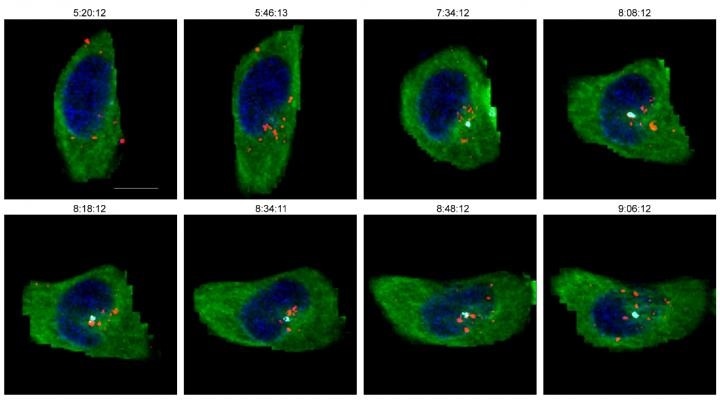The process of cells being infected by HIV-1 strains is widely known to undergo the following stages; fusion of the membrane, release of the viral core, reverse transcription, disassembly of the capsid in the cytoplasm, nuclear penetration of the viral genome, and integration of the viral genome, followed by the self-reproduction of HIV-1 using the host cell system.

Time-lapse fluorescence snapshots of the HIVVpr-mCherry (NL4-3(KFS)) in TZM-bl cells. The aggregation of viral particles in the MTOC and their transport into the nucleus were dynamically traced. Stained for DNA (blue), MT (green), and MTOC marker protein γ-tubulin (turquoise). Scale bars, 10 μm. Image Credit: ©Science China Press.
But current studies have also identified the presence of viral capsid in the nucleus, playing significant roles like immune escape and selection of the integration sites.
The current report has demonstrated that the HIV-1 viral capsid uncoated close to the chromosome integration site. Given that the size of the capsid-carrying virus is relatively larger than the nuclear pores, researchers are still unaware of how the viral cores enter the barrier of the nuclear membrane.
In response to this mystery, selected elements of the host cells and HIV-1 are labeled differentially such that the interaction between the virus and the host cell can be monitored dynamically.
It was observed that after penetrating the cell, the viral particles traveled along the microtubules and selectively collected at the microtubule organization center (MTOC), causing the neighboring nuclear envelope (NE) to go through deformation, invagination, and restoration processes to develop a nuclear vesicle. The viral particles were wrapped inside this nuclear vesicle.
The inner membrane of the nuclear vesicle then breaks down to discharge the HIV-1 into the nucleus. Such a phenomenon is analogous to the cell endocytosis, and hence, it is referred to as the “nuclear endocytosis-like pathway.”
Factors involved in this process were initially examined. This finding extended one’s interpretation of the complexity of HIV-1 nuclear entry, which may offer a new understanding of HIV-1 virology. The viral biology and molecular details of the mechanism require additional elucidation.
Source:
Journal reference:
Li, X., et al. (2020) HIV-1 viral cores enter the nucleus collectively through the nuclear endocytosis-like pathway. Science China Life Sciences. doi.org/10.1007/s11427-020-1716-x.